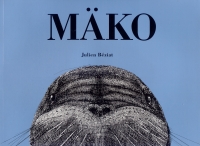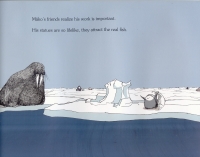| ________________
CM . . .
. Volume XIX Number 39. . . .June 7, 2013
excerpt:
Mäko is an artist. He also happens to be a walrus who lives in the Arctic. Every day he dives deep into the ocean beneath the ice floes that are his home in order to seek his source of inspiration -- fish of all shapes and sizes. Mäko sculpts fish for the sheer pleasure of doing it, using his tusks to cut and shape the ice blocks. His art also serves a practical purpose as they form a life-size map of the different types of fish and where they can be found in the waters below, guiding his other seal and penguin friends to their food. In fact, the fish below find his sculptures so life-like that they congregate below their corresponding likenesses.
Mäko is a beautifully illustrated and well-designed picture book, with its limited colour palette of white, slate greys, steely and cerulean blues bleeding to the edges of each spread to give a sense of the expanse of the world Mäko inhabits both above and beneath the ice. One spread worthy of note is that with all of Mäko's friends begging him to save them from their plight, piled together in a disconsolate heap, with the figures diminishing in size until they are mere dots on the page. Béziat puts the most effort into the intricate cross-hatching to capture the bulky grace of Mäko, whereas his friends are sketched with a more cartoon-like feel. It is noteworthy to point out that there are no dialogue tags in the book, and the titular hero of the story does not speak but lets his actions and work speak for him. The size and placement of the text also help convey what is happening in the story; for example, the "craaaack" of the ice floes is displayed in large, sprawling capital letters. Since there are a lot of details in the illustrations that would be lost in a storytime, this story can be best experienced when shared with a child, or if a child explores it on her own. Mäko is a book that could support curriculum in its suggestion that climate change could be responsible for the upset in the delicate balance of the ecosystem in which Mäko and his friends inhabit. More importantly, Béziat uses his narrative to explore themes touching upon the nature of artistic life, itself. He shows both the pleasure of creation in solitude, of 'art for art's sake,' as well as the dynamics between an artist and his audience. Mäko's friends need his maps to find food; similarly, Mäko needs his friends to inspire him to take bigger risks, even the risk of knowing his creation will be destroyed. Mäko's art also reconstructs reality as, at the story's end, he returns to his life of sculpting and "even imagines new fish." The last spread shows Mäko displaying baffled and delighted surprise at meeting a brightly hued orange fish below the waters, corresponding to the sculpture he just made above the surface. Could it be that Mäko's art no longer imitates life, but seems capable of bringing forth, or at least summoning, life instead? The reader must decide that for him or herself. With its balance of whimsy and gravitas, Béziat's debut picture book is a delight for children and for those who want to delve a bit deeper below the surface (much as Mäko does) to find inspiration and meaning on the process and motivation for artistic creation. We look forward to seeing more of Béziat's work and hope that readers young and old have more opportunities to 'admire his work' and begin to understand a storyteller's 'passion for art', just as Mäko's friends did. Recommended. Ellen Wu holds a MFA in children’s literature and is the teen services librarian at Surrey Libraries in BC.
To comment
on this title or this review, send mail to cm@umanitoba.ca.
Copyright © the Manitoba Library Association. Reproduction for personal
use is permitted only if this copyright notice is maintained. Any
other reproduction is prohibited without permission.
NEXT REVIEW |
TABLE OF CONTENTS FOR THIS ISSUE
- June 7, 2013.
AUTHORS |
TITLES |
MEDIA REVIEWS |
PROFILES |
BACK ISSUES |
SEARCH |
CMARCHIVE |
HOME |

 One day, the ice floes snap, destroying every one of Mäko's sculptures except that of one lone halibut. Because Mäko's map has been destroyed, now the fish no longer return to the same waters, and his friends have nothing to eat. They clamour for him to do something, anything, to make the fish come back. Mäko, commissioned to create a piece of art that will save his friends, stays up all night to do so after much ruminating. He unveils a life-size rendering of a whale to the consternation of his friends. How can they possibly eat a whale? Before Mäko is subjected to more criticism for his newest sculpture, a whale destroys it by breaking through the ice floe on which its likeness rests, spilling thousands and thousands of fish for Mäko's friends to feast on. The story ends with the text stating that now his friends understand not only the importance of Mäko's art, but also the passion that drives him.
One day, the ice floes snap, destroying every one of Mäko's sculptures except that of one lone halibut. Because Mäko's map has been destroyed, now the fish no longer return to the same waters, and his friends have nothing to eat. They clamour for him to do something, anything, to make the fish come back. Mäko, commissioned to create a piece of art that will save his friends, stays up all night to do so after much ruminating. He unveils a life-size rendering of a whale to the consternation of his friends. How can they possibly eat a whale? Before Mäko is subjected to more criticism for his newest sculpture, a whale destroys it by breaking through the ice floe on which its likeness rests, spilling thousands and thousands of fish for Mäko's friends to feast on. The story ends with the text stating that now his friends understand not only the importance of Mäko's art, but also the passion that drives him.